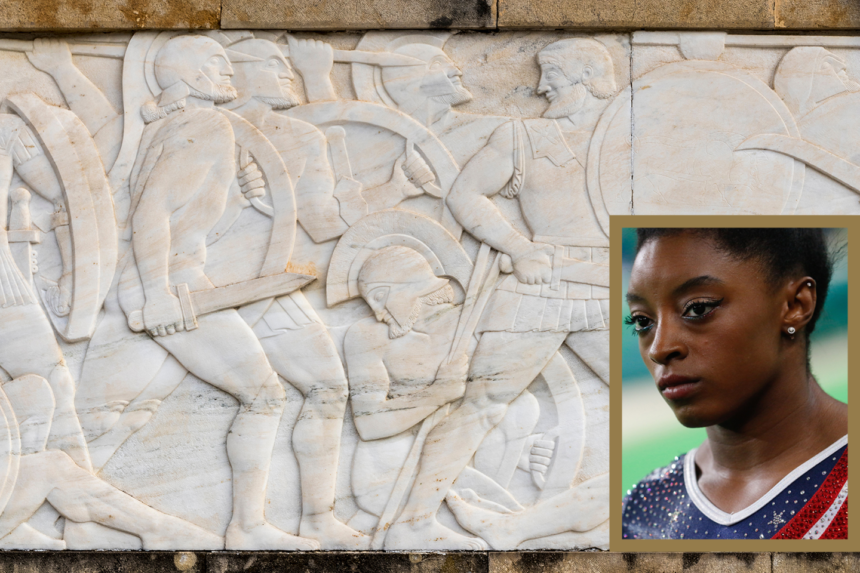Sailing around the Greek Isles and reading up on the Spartans is how I’ve spent most of my summer. Both of my mother’s parents were Spartans, and the line goes back a very long way. My grandfather even left our family house to the state and today it’s a beautiful museum right in the heart of Sparta.
Grandfather lived to a ripe old age despite being repeatedly wounded during his years as a cavalry officer in the Balkan Wars, setting an example for four of my mother’s brothers, who immediately volunteered for frontline duty when the Italians invaded Greece on Oct. 28, 1940. I remember my grandfather suffering from old wounds but never, ever complaining.
That was then, but this is now. When gymnast Simone Biles threw in the towel and pulled out of several Olympic events, saying “I have to focus on my mental health,” her corporate sponsor Visa lauded her “incredibly brave decision.” The Spartans might have come up with a different analysis.
Sports people outing themselves as suffering from mental health problems is turning from a trickle into a steady flow. Criticizing them might lead to cancellation, which is something I welcome—given that history and common sense cancels their cancellation. So there!
But before I go on about the Spartans and athletes like Naomi Osaka and Simone Biles, whom the media now considers superheroes for quitting, a word about what the average American thinks: Kneeling, gesturing, and turning their backs on the flag is seen as moronic, self-indulgent, and a kick in the teeth for those whose loved ones died defending that very flag. The average American does not want to see athletes who hate America represent Uncle Sam.
But try telling that to the flimflam men who run the media and professional sports, and who are themselves run by sound bites, focus groups, and advertisers. “You’ll wonder where the yellow went, when you brush your teeth with Pepsodent!”
There was no yellow to wonder about 2,500 years ago because there were no yellowbellies among the 300 Spartans who faced hundreds of thousands of Persians in Thermopylae in 480 BC. That summer when King Leonidas led his tiny army to fight against the Persian invasion, none of them imagined that some 2,500 years later people around the globe would be writing books and making movies about them. That summer they merely felt they were doing their duty. Spartan mothers told their departing sons to come back with their shields or on them. And then there’s Missouri Congresswoman Cori Bush. “I stand with Simone Biles,” she tweeted. “You’re reminding Black women that we can take the space we need for ourselves.”
The Persian kingdom was so large at the time that Herodotus described it as stretching from sunrise to sunset, and legend had it that Xerxes’s army was 3 million strong. The ancient historian Taki has it as 300,000 to half a million, but the 300 Spartans were hardly daunted by the numbers. When King Xerxes was informed of the disparity, he offered the Spartans free passage back home. They refused. Then he demanded they at least put down their arms. “Molon labe,” came the answer, “come and get them.” Finally, Xerxes threatened that there were so many archers in his army that their arrows let loose would darken the sky. “Good,” came the answer, “we like to fight in the shade.”
When Xerxes sent spies he was stunned to learn the Spartans were wrestling, while others were casually grooming and combing their long hair.
The Spartans’ confidence was not as foolhardy as it seemed. The mountain pass at Thermopylae was a natural bottleneck—150 feet wide at its narrowest—negating the numerical strength of the Persians. The fighting began and it was constant and relentless. A repeated maneuver whereby the Spartans would turn their backs feigning flight, then reform their ranks and cut down their pursuers worked time and again. After two days of nonstop combat the Spartans were almost at full strength while the Persians had lost thousands. Then came Ephialtes, a name that has come to mean “nightmare” in modern Greek. A local who knew of a path behind the Spartan line, Ephialtes sold his secret to Xerxes. As defeat neared, Leonidas chose to die with his troops, even though they begged him to retreat and fight another day. Glory is everlasting, he said.
Herodotus describes the Spartans as frenzied soldiers who achieved a glorious death, killing 20,000 Persians. Even unarmed, the Spartans fought on with bare hands, while the Persians preferred to strike from a safe distance. “Passerby, tell the Greeks that here we lie having done our duty,” reads a monument celebrating their sacrifice. Perhaps the purple and green-haired black lesbian Raven Saunders who protested so-called intersectional oppression while receiving her silver medal should read up on the Spartans. But then, better not.
Image Credit:
above: detail of a memorial monument in Thermopylae, Greece to King Leonidas of Sparta, the 300 Spartans, and the 700 Thespians who fought against the Persians at the Battle of Thermopylae in 480 BC. ( Joaquin Ossorio Castillo/Shutterstock) inset: Simone Biles at the 2016 Olympics in Rio de Janeiro, Brazil (Agência Brasil Fotografias)

Leave a Reply